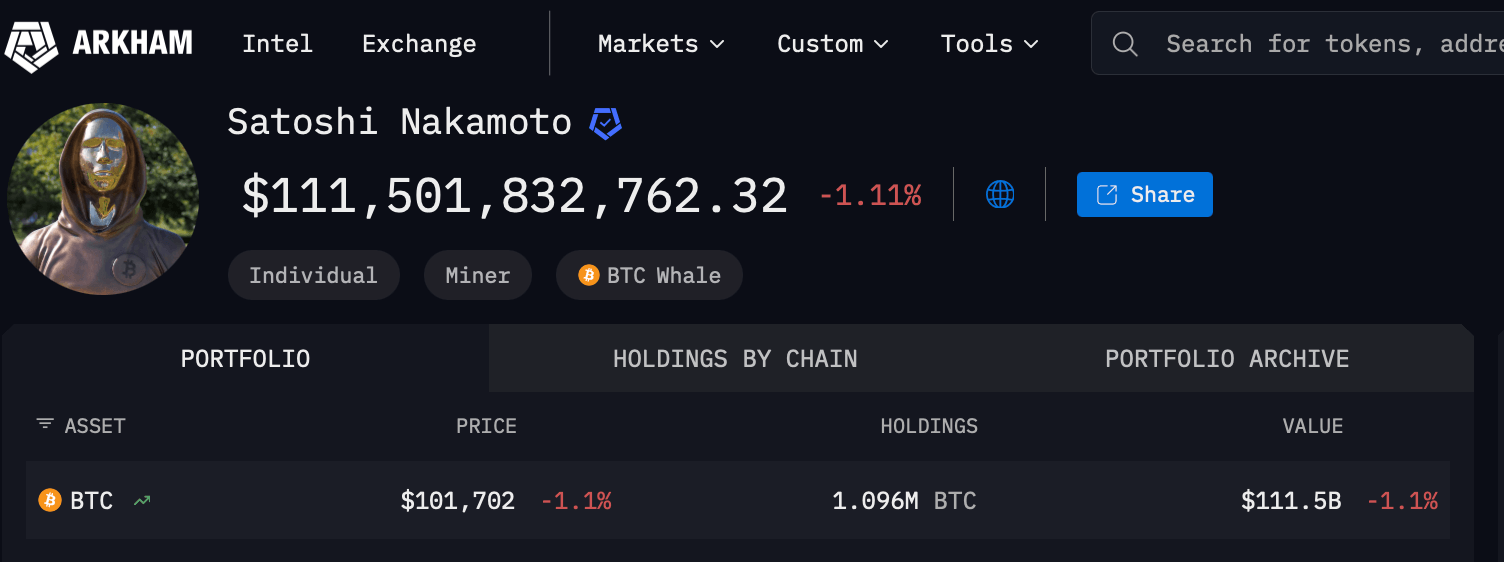BIP39 and Satoshi Nakamoto: Why Modern Seed Phrases Don’t Apply
Viral posts on X, formerly Twitter, have fueled speculation throughout 2025 that a simple sequence of 24 words could grant access to Satoshi Nakamoto‘s vast bitcoin fortune, valued at approximately $111 billion as of Nov. 12, 2025, when bitcoin traded around $101,702 per coin.
For instance, one post from Nov. 10, 2025, stated: “Fun fact: 24 words in the right order can unlock 111 billion. That fact should scare you,” emphasizing the supposed vulnerability.

This X post is one of many that claim Nakamoto’s wallets can be confiscated using 24 words.
These memes often resurface during bitcoin price fluctuations, drawing thousands of views and engagements by highlighting the dramatic scale of Satoshi’s holdings, estimated at 1.1 million BTC based on early mining patterns like the Patoshi blocks. The problem is, they are not facts.
This same X post drew the attention of the lead researcher at Galaxy Digital, Alex Thorn, and Sani, the onchain analyst and operator of timechainindex.com. “Fake news, dumb slop,” Thorn stated to the individual who posted the ‘Fun fact.’ “Satoshi’s coins are spread across many pay-to-public-key (P2PK) addresses.. i.e., many public private key pairs, not one,” Thorn quipped.
The Galaxy researcher further added:
“But even worse: hierarchical deterministic (HD) wallets (BIP-32) and mnemonic seed phrases (BIP-39) weren’t invented until 2012/2013.”
Timechainindex founder Sani agreed. “22,471 private keys to be exact, to unlock 1,123,540 BTC,” he stated. “Good luck to all those brave retarded souls who think they can crack even 1 of those.” Sani can often be seen debunking hyped X posts talking about big onchain moves with no substance behind them.
Blockchain analytics platforms, such as Arkham Intelligence, publicly track these addresses, showing Nakamoto has never transacted since 2010, yet the posts persist as misinformed clickbait. The core of these claims revolves around BIP39, a Bitcoin Improvement Proposal (BIP) that standardizes mnemonic seed phrases—groups of words representing cryptographic keys—to simplify wallet recovery.
Proposed on Sept. 10, 2013, BIP39 allows users to generate deterministic wallets from 12- or 24-word phrases derived from a 2,048-word list, providing 128 to 256 bits of entropy. This system has become ubiquitous in modern cryptocurrency wallets, enabling secure backups without exposing raw private keys. However, Satoshi, who mined bitcoin from January 2009 through 2010 and was last active in public in December 2010, operated before this standard existed.
Read more: Bitcoin’s Scalability Foreseen by Satoshi Nakamoto to Outpace Visa, Historic Email Reveals
Nakamoto’s final public message on Dec. 12, 2010, addressed denial-of-service vulnerabilities in Bitcoin’s software, marking the end of their involvement long before mnemonic phrases became a feature. As a result, applying BIP39 retroactively to Satoshi’s wallets misrepresents the technology’s timeline and applicability. Basically, early versions of Bitcoin software, used by Satoshi, generated raw private keys—256-bit numbers represented in hexadecimal or other formats—without the user-friendly mnemonic conversion introduced later.
These keys were stored directly in wallet files, requiring exact knowledge or possession to access funds, rather than derivable word lists. Satoshi’s addresses, identified through blockchain analysis, hold coins from the genesis block onward, but no modern seed phrase could reconstruct them because the underlying generation method predates BIP39 by years. This historical disconnect means that even if someone possessed a hypothetical 24-word phrase, it would not interface with the original key structure.

Source: Arkham Intelligence on Nov. 12, 2025.
Blockchain explorers like Blockchair, mempool.space, or Arkham confirm the dormancy of these addresses, with no outgoing transactions recorded in 2025 or prior years, which essentially highlights the irrelevance of mnemonic-based attacks. Even if Satoshi’s keys aligned with contemporary standards, or anyone’s for that matter, brute-forcing a 256-bit private key remains mathematically infeasible, with 2^256 possible combinations equaling approximately 1.1579 x 10^77 unique possibilities. Try out “Mnemonic Slots” for yourself here.
You will not win the lottery. This is because the unique possibilities figure dwarfs the estimated 10^78 to 10^82 atoms in the observable universe, often cited as around 10^80, making random guessing equivalent to searching for a specific atom across cosmic scales. Current global computing power, even at 10^21 operations per second, would require an average of 1.8 x 10^48 years to crack such a key—vastly exceeding the universe’s 13.8 billion-year age.
Social media posts often invoke this “scare factor” for engagement, but they overlook that proper key management renders such attacks theoretical at best. Public blockchain data provides irrefutable evidence against any successful access attempts, as all transactions are transparently recorded and monitored by services like blockchain explorers and full nodes.
These persistent myths highlight broader cryptocurrency education gaps, where simplified narratives on platforms like X amplify fears without validity or context, even as bitcoin’s design ensures long-term security through cryptographic principles established in 2009. The engagement shows—While the misinformed X post received more than 1,200 likes, Thorn’s reply only hit 389, and Sani’s saw around 77.
- When was the BIP39 standard for mnemonic seed phrases introduced? The BIP39 standard was proposed on Sept. 10, 2013, standardizing word-based recovery for Bitcoin wallets.
- What type of keys did Satoshi Nakamoto use in early Bitcoin? Satoshi used raw 256-bit private keys generated by early Bitcoin software, not mnemonic word phrases.
- How many possible combinations exist for a 256-bit encryption key? A 256-bit key has 2^256 combinations, or about 1.1579 x 10^77 possibilities.
- Has Satoshi Nakamoto’s wallets shown any activity in 2025? No transactions have occurred from Satoshi’s estimated addresses in 2025, per public blockchain data.
免责声明:本文章仅代表作者个人观点,不代表本平台的立场和观点。本文章仅供信息分享,不构成对任何人的任何投资建议。用户与作者之间的任何争议,与本平台无关。如网页中刊载的文章或图片涉及侵权,请提供相关的权利证明和身份证明发送邮件到support@aicoin.com,本平台相关工作人员将会进行核查。




